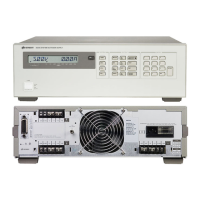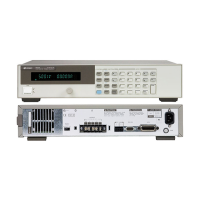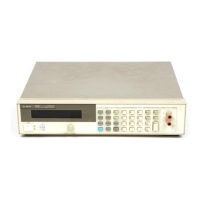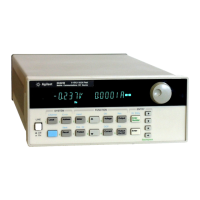4
INH Input
The inhibit input (INH) is a low true, TTL compatible logic input, which is used to remotely disable all outputs
of the supply. It provides a way to disable the supply that is independent of computer control over the GPIB.
The INH input signal is applied through connector J702 on the rear of the supply (See Figure 1). In addition to
disabling the outputs, the INH input also opens all RLY terminals.
When the supply is disabled by the INH input, all outputs will remain disabled until the supply receives a
RIRST command (explained later). If the INH input is still true when the supply is reset, the outputs will not be
enabled.
The status register of each output contains an additional INH bit, which is available only with Option 750 (See
Figure 2). These INH bits all reflect the state of the single INH input. This allows INH to be unmasked to the
fault register to generate a fault or SRQ. INH is in the ninth position in each status register and has a bit weight
of 256. Note that the addition of a register bit does not require any change in the way that the standard
programming commands are used.
RLY Controls
The relay controls (RLY) are designed to be used with external user-supplied relay circuitry so that the outputs
of the power supply can be physically disconnected from the load (or system). These RLY controls are
available through connector J703 (See Figure 1). Each of the four RLY controls can sink 120mA for controlling
external relays directly from an external power supply. Because they are also open collector, they can also
provide low true, TTL compatible logic levels for connecting to a relay control box.
The RLY controls are programmed with the RELAY and OUT command (explained later). They can also be
operated using the front panel OUTPUT ON/OFF function key. Figure 3 shows how to connect either a relay or
a logic circuit to the RLY controls.
External Connections
As shown in Figure 1, mechanical connections to the FLT, INH, and RLY circuits are made through screw
terminals on the removable 4 and 8 position barrier blocks. These barrier blocks plug into the J702 and J703
connector sockets located on the rear of the power supply.
Loosen the screws on top of the terminal block. Strip your wires back approximately 0.2in. (5mm). Insert wires
fully into the screw terminals to prevent shorted connections. The screw terminals can accommodate wire sizes
from AWG 14 to AWG 28 (Metric 1.5-0.5mm
2
). Refer to the label above the terminal block to make sure that
you are inserting your wires into the correct opening. Tighten the screws onto the wires.
Note To prevent RFI interference, use shielded or twisted pair wiring for FLT and INH connections.
To prevent ground loops when shielded wire-is used, connect only one end of the shield to
chassis ground. INH low and RLY control low are connected to ground.
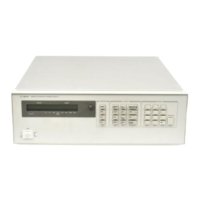
